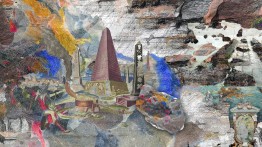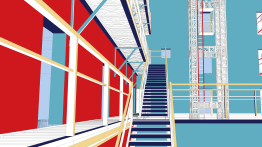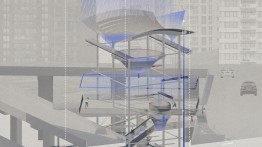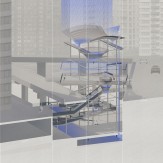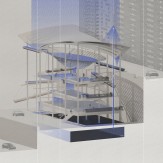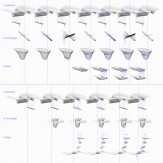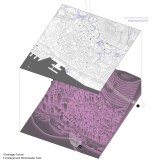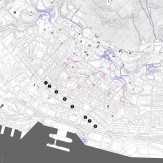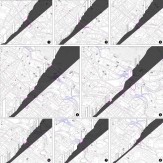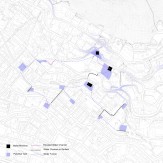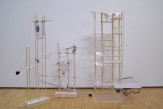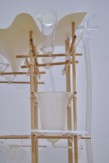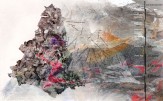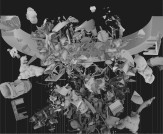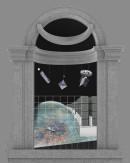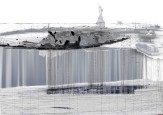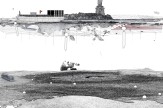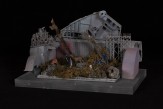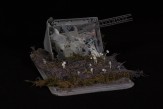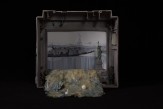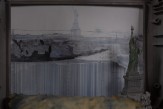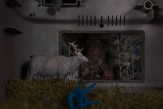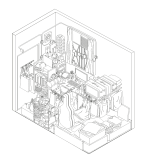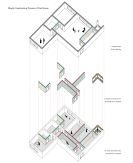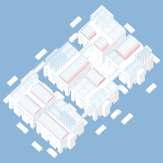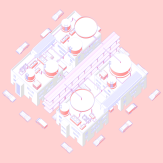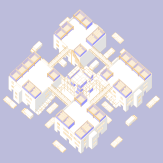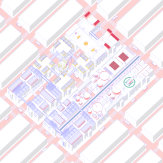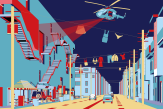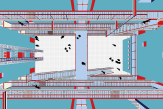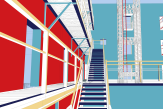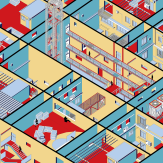MASTER OF SCIENCE IN ARCHITECTURE SPRING 2022
GRADUATE THESIS
Lydia Kallipoliti, Assistant Professor
Crossing between scales and between fields of inquiry—via science, narrative, kinship, species, and politics—a Thesis is unavoidably a journey engaging diverse forms of collective life and the ways in which this life may be sheltered and enabled through architecture. This journey, these crossings, need noise to avoid the construction of a projected exclusivity, what the sociologist John Law calls a ‘one-world world,’ a homogeneous space in which everything fits perfectly together.
During Thesis, we zoomed out to imagine new cartographies of the world, like Bruno Latour has called for, in his 2017 book Down to Earth. Unlike this masterplan, we also zoomed in to tell granular stories on small objects, their details and analytical composure. Through this specificity, one can speak of enlarged contexts understood as spatial and temporal phenomena. As anthropologist Anna Tsing prompts us, “BIG HISTORIES ARE ALWAYS BEST TOLD THROUGH INSISTENT, IF HUMBLE, DETAILS.” Humility and precision are critical in the imagination of alternative visions because they make cracks in the apparatus of power.
Via zooming in and out, Thesis allows every student to define their own disciplinary ground or field of inquiry in order to elaborate the ways in which architecture constructs, distributes, and leverages power, as well as how spaces are shaped by larger political agendas. In this sense, the first step for the development of each Thesis was the identification and definition of a humble, small, and seemingly insignificant object/situation, space, condition/phenomenon, to analyze, draw, describe and interrogate. Each student created their own text and drawings as a mythology of forensic analysis, like Roland Barthes’ Mythologies in 1957, and extrapolated disciplinary questions via the specificity of these analyses. By starting from this visual and narrative mythology, the theses established a process of transformation that changes radically its field into an unknown destination that is still in formation.
The studio’s role was to help each student to surface their Thesis in a way that resonates with the discipline and simultaneously introduces new elements of discussion and debate through a final body of work. Consisting of independent research, focused exercises, group workshops, seminar sessions, visiting lectures, and progress presentations, the goal was to guide students in the development of research and design methodologies for the articulation of a Thesis proposal that advances architecture as a discipline and assumes responsibility for architecture’s political, social, ecological, and social agency.
Projects
-
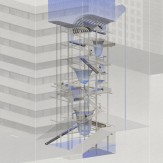
Building Water Machine
-

Museum of Post Natural History: The Hall of the Plastisphere
-

Strong Wildness: Outlaw Construction as a Paradigm for Urban Renewal
Back
Building Water Machine
Xiyu Chen
The solid surfaces of cities have long been impenetrable. The buildings keep rainwater out, making it a useless natural resource and even a dangerous flood hazard. Suppose buildings are permeable water machines, allowing rainwater to enter and pass through spaces in various ways while producing wetscapes such as mist, fountains, and waterfalls. In that case, rainwater may become a beneficial element for the urban environment and human life. This thesis studies the impact of rainwater on the microclimate of specific spaces, including temperature and humidity, and the effect of diverse wetscapes on senses like vision, hearing, and touch, exploring the possibilities of rainwater running in a building.
Hong Kong is a wet city where the average annual rainfall is more than 2,000 millimeters. Massive stormwater surges regularly flooded Hong Kong’s low-lying areas. To control flooding, the government has built a rainwater system that catches stormwater, routing it underground directly to the sea, without reusing it. However, this approach overlooks the quality of rainwater—it provides only drainage, instead of a way of living with continuous rainfall, which requires a sustainable rainwater control system.
A series of new water machines will work in the northwest area of the Hong Kong island. Each water machine is an apparatus that creates a chain reaction of water flow through specifically shaped roof structures and various water channels, like fixed gutters, pipes, and movable tubes. The water machine is also a building that provides public spaces shaped by the structure’s wetscapes, such as an outdoor gym cooled by mist, a waterpark shaded by a water tank, or a public balcony with traffic noise dampened by a waterfall. These machines are small-scale, connected living tanks that compose an alternative rainwater regulating system in the city. This system celebrates the process of collecting and reusing rainwater by triggering ever-changing movement of water flows. At the same time, the system makes our wet future more habitable by generating public spaces adapted to endless rain.
Museum of Post Natural History: The Hall of the Plastisphere
Foivos Geralis
In an era of ecological collapse and extreme anthropogenic alterations to the Earth, the objective of this project is to rethink of what the natural history museum is, and what it should convey, by disrupting the facile and digestible interpretations of complex and uneven temporal phenomena that the museum has historically assumed. Through this project I explore ways that would allow for a visceral reckoning of the new landscapes of plastic pollution. The project unfolds by examining and critiquing the dominant medium of the natural history museum, the diorama; by exploring the 'Plastisphere,' questions of plastic pollution, and the global dump that have emerged as a new Nature; and by speculating about and designing a series of analytical metonymic scenes of ecological ruination, displaced in futurity.
Strong Wildness: Outlaw Construction as a Paradigm for Urban Renewal
Tao He
Outlaw construction is a so-called unlawful, identityless, and non-official building behavior, and a common phenomenon in contemporary Asia when residents are dissatisfied with the living environment they are offered. Outlaw construction is a spontaneous or occasionally intentional building behavior which is full of exuberance and has its own specific aesthetic. It is the ideal embodiment of the vitality of social bottom's daily life that grows out from the urban cracks. The object of this thesis is to provide spatial protocols, elements, and a system of contracts to enable and initiate spontaneous construction action, livelihood, and community richness.

